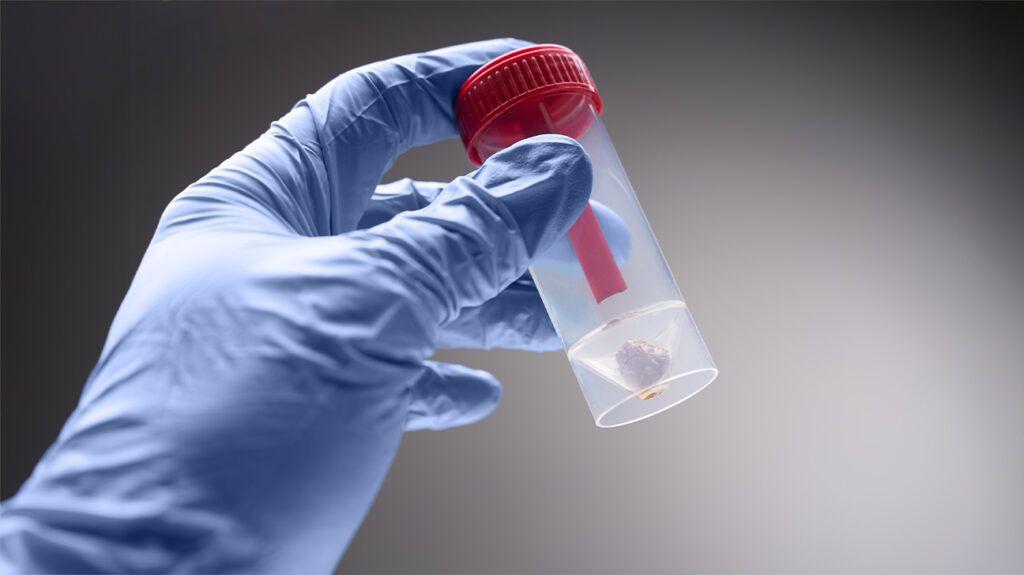A stool test is a diagnostic procedure that involves analyzing fecal matter, or poop, to check for signs of infection, inflammation, or disease. The specific analysis depends on a person’s symptoms and medical history.
A person will have to collect their own stool sample and give it to a medical professional, who can examine it visually. They will then send it to a lab for examination under a microscope.
This article describes what a stool test is, what it checks for, and who may need the test. It also provides information on preparing for a stool test, how to collect a stool sample, and more.

Doctors may recommend stool testing for people who experience symptoms of gastrointestinal disease, such as:
- gas
- bloating
- abdominal pain or cramping
- constipation
- diarrhea
- changes in bowel habits
- blood or mucus in the stool
The
As such, doctors may recommend stool testing for people at increased risk of developing this disease, such as:
- people between the ages of 45 and 75 years
- individuals with an inflammatory bowel disease (IBD), such as ulcerative colitis or Crohn’s disease
- individuals with a personal or family history of colorectal cancer or colorectal polyps
Stool tests that can help detect colorectal cancer include:
- The guaiac-based fecal occult blood test (gFOBT): A yearly test that detects blood from a stool sample.
- The fecal immunochemical test (FIT): Similar to the gFOBT, this annual test also detects blood from a stool sample.
- The FIT-DNA test: This combines the FIT test with a test that checks for altered DNA from an entire bowel movement. Doctors typically recommend this test once every 3 years.
A doctor will provide specific instructions on preparing for a particular stool test.
Many fecal occult blood tests do not require any specific preparation. However, doctors may recommend that people receiving certain gFOBT tests temporarily avoid certain foods, supplements, or medications that may interfere with the results.
For example, doctors may recommend that people decrease their daily vitamin C intake from all sources to less than 250 milligrams (mg) per day. Exceeding this amount may give false-negative results on certain gFOBT tests.
Doctors may also advise avoiding the following, which could otherwise give false-positive results:
- Nonsteroidal anti-inflammatory drugs (NSAIDs): Examples include ibuprofen, naproxen, and aspirin.
- Red meats: Traces of blood from these meats may be detectable in the stool sample, giving false-positive results.
- Certain raw fruits and vegetables: Some of these contain reddish-brown colored proteins called plant peroxidases that can give false-positive results for blood. Examples
includeTrusted Source :- turnips
- parsnip
- red radish
- horseradish
- broccoli
- cauliflower
- cantaloupe
A doctor or nurse will explain how to collect a stool sample and provide a small plastic container.
The United Kingdom’s National Health Service (NHS) provides the following instructions for collecting a stool sample:
- Step 1: Fill out the container label with details such as name, date of birth, and the sample date.
- Step 2: Place one of the following inside the toilet to catch the stool, ensuring that the stool does not touch the inside of the toilet:
- an empty potty
- a plastic container
- some plastic wrap stretched over the rim of the toilet, beneath the seat
- Step 3: Use the plastic spatula that comes with the container to place a sample of the stool inside the container, then screw the lid shut. In most cases, a person should aim to fill around one-third of the container.
- Step 4: Tip the remaining stool into the toilet, then place the collection spatula in a plastic bag, tie it up, and dispose of it in the bin.
- Step 5: Wash the hands thoroughly with soap and warm water.
After collecting the sample, a person should give it to the medical professional as soon as possible. Delaying this step can cause bacteria within the sample to multiply and could affect the accuracy of the test.
If a person cannot take in the sample immediately, a doctor may advise placing it in a sealed plastic bag and storing it in the refrigerator.
Medical professionals will
Macroscopic analysis
Macroscopic analysis involves making assessments about the stool’s obvious characteristics, such as:
- the quantity of stool
- the stool’s appearance, such as its color, shape, and consistency
- the stool’s odor
- the presence of mucus or blood
Microscopic analysis
Microscopic analysis involves examining the stool under a microscope to check for the following:
- Infectious pathogens: These may be bacterial, viral, or parasitic. Examples include:
- Helicobacter pylori bacteria
- Clostridioides difficile bacteria
- rotavirus
- adenovirus
- giardia
- entamoeba
- Blood in the stool: High levels may indicate GI bleeding, which could occur
due to:Trusted Source - IBD
- ulcerative colitis
- diverticulitis
- colon polyps
- benign tumors
- cancer
- Fat in the stool: High levels may indicate fat malabsorption or steatorrhea.
- Sugars in the stool: Depending on the type of sugar present, high levels may indicate:
- galactosemia, a rare hereditary disorder that affects carbohydrate metabolism
- sucrose malabsorption
- lactose intolerance
- fructose intolerance
- Pancreatic enzymes, such as Elastase-1 and chymotrypsin: These give an indication of pancreatic function.
- Calprotectin enzyme: High levels of this enzyme may indicate one or more of the following:
- infections
- inflammation from IBD or other causes
- cancers, such as colon cancer
This section answers some common questions about stool tests.
How long does a stool test take?
Cologuard is a screening test approved by the Food and Drug Administration (FDA) for cancers of the colon and rectum. The Cologuard website states that the turnaround time for receiving the stool test results is less than 2 weeks from when a person posts the sample.
The NHS also notes that the results of a bowel screening test should be available within 2 weeks of submitting a stool sample.
What do stool test results mean?
Doctors may recommend different types of stool tests to diagnose different GI diseases. The results of these tests will vary according to the type of test a person receives.
For people receiving fecal occult blood tests to screen for colorectal cancer, a positive result indicates bleeding somewhere in the GI tract. However, this is not always a sign of cancer. Other conditions that can cause this include:
- GI ulcers
- hemorrhoids
- polyps
- benign tumors
Doctors will usually recommend further testing to determine the exact cause and location of the bleeding. The most common test is a colonoscopy, which is a procedure that uses a flexible camera to view inside the GI tract.
A stool test is a diagnostic procedure that involves analyzing fecal matter to check for signs of infection, inflammation, or disease within the gastrointestinal (GI) system.
When analysing stool samples, laboratory technicians consider the stool’s appearance and odor, as well as any obvious signs of blood or mucus.
They will also examine the stool under a microscope and apply special stains and other chemicals to help identify specific signs of infection or disease.
Doctors will advise whether a specific stool test requires any special preparation and on collecting and storing a stool sample. Typically, a person should receive the test results within 2 weeks.


